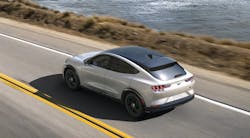The push for electric vehicles (EV) is all over the news these days. All over the world, too.
In the UK, the Government’s Net Zero Strategy could force auto manufacturers to significantly increase annual EV sales in order to accelerate the shift to zero-emission passenger cars. According to the UK Department for Business Energy & Industrial Strategy, the proposed zero emission vehicle mandate to take effect in 2024 could result in fines for auto makers who do not phase out the gas and diesel cars fast enough.
Here in the U.S., in spite of the Biden Administration’s public support for EV, the Corporate Average Fuel Economy (CAFE) standard was recently revised and rebranded as the Safer, Affordable Fuel-Efficient (SAFE) vehicle standard. But the energy efficiency targets for model years 2021-2026 were substantially lower than those under the 2020 CAFÉ. And the $7,500 maximum federal tax credit for the purchase of EV was left in place (except for Tesla and GM, which sold more than 200,000 EV), but not renewed.
The real EV policies are being passed at the state level.
Since California issued its Low Emissions Vehicles regulations limiting greenhouse gas (GHG) emissions, more than 30 percent of new U.S. autos now comply. And other states continue to consider requiring new cars to be zero-emission since California’s governor issued his Executive Order requiring such sales by 2035. Although total auto sales were off 23 percent in 2020, arguably due to the pandemic, EV sales still improved.
Personally, I knew that EV was more than a passing fad when Ford introduced the Mustang Mach-E! (above)
There is no question that EV have advantages over gasoline-powered cars… the largest one, of course, being the ability to drive past those gas stations with their ever-rising fuel prices. And they don’t directly emit GHG and pollutants, including CO2, CO, NOx, particulates, and other unburned hydrocarbons. But are they really as environmentally friendly as the media reports? They still rely on batteries that require energy to produce and toxic components to be disposed of at end-of-life.
Shortly after launching Clark’s Remarks in 2013, I wrote about embodied-energy (simply put, the amount of energy required to produce a material). And earlier this year, I specifically addressed the need to include embodied energy in any discussion of a product’s sustainability.
There are also some practical considerations to address before we accept EV as the environment’s panacea. An article in Nature in September 2020 entitled “Electrification of light-duty vehicle fleet alone will not meet mitigation targets” concluded that reaching the 2 deg. C global climate action target with EV alone would require replacing more than 350 million vehicles currently on the road with EV (90% of the vehicles presently in service), consumption of 50 percent of the country’s electric energy demand, and excessive amounts of critical materials.
Call me a pessimist, but that’s probably not going to happen.
Some areas (think Texas) don’t have adequate grid capacity without adding millions of EV charging stations, and many Americans live in multifamily buildings that will not easily be converted so that every EV has its own charging station. Although the technology is continually improving, it still takes time to fully charge the vehicle which, for most, will be done at home. Eventually, AAA will probably carry an EV charger. But in the meantime, if you were stranded for hours in one of the multi-car, ice-related accidents over the long Christmas weekend, you had a better chance of getting gas to keep your engine (and heater) running, than to get an EV charge. On the plus side, EV require less maintenance. On the negative side, when they do require maintenance it can be pricey, and they’re expensive to start with.
EV are an obvious part of the climate change solution, but reducing our dependency on personal cars by developing alternate transportation solutions make a lot more sense to me.
Here in South Florida, we have high-speed rail between Miam, Fort Lauderdale, and West Palm Beach. In 2022, the service will extend to Orlando, connecting south and central Florida. It will start carrying passengers in early 2023, and the 235-mile Miami to Orlando ride will be faster than cars, cheaper and more convenient than planes, and safer and more sustainable than either.
##########
A regular contributor to HPAC Engineering and a member of its editorial advisory board since 2012, the author is a principal at Sustainable Performance Solutions LLC, a south Florida-based engineering firm focusing on energy and sustainability. Email him at [email protected].
About the Author
Larry Clark
A member of HPAC Engineering’s Editorial Advisory Board, Lawrence (Larry) Clark, QCxP, GGP, LEED AP+, is principal of Sustainable Performance Solutions LLC, a South Florida-based engineering firm focused on energy and sustainability consulting. He has more than two dozen published articles on HVAC- and energy-related topics to his credit and frequently lectures on green-building best practices, central-energy-plant optimization, and demand-controlled ventilation.
